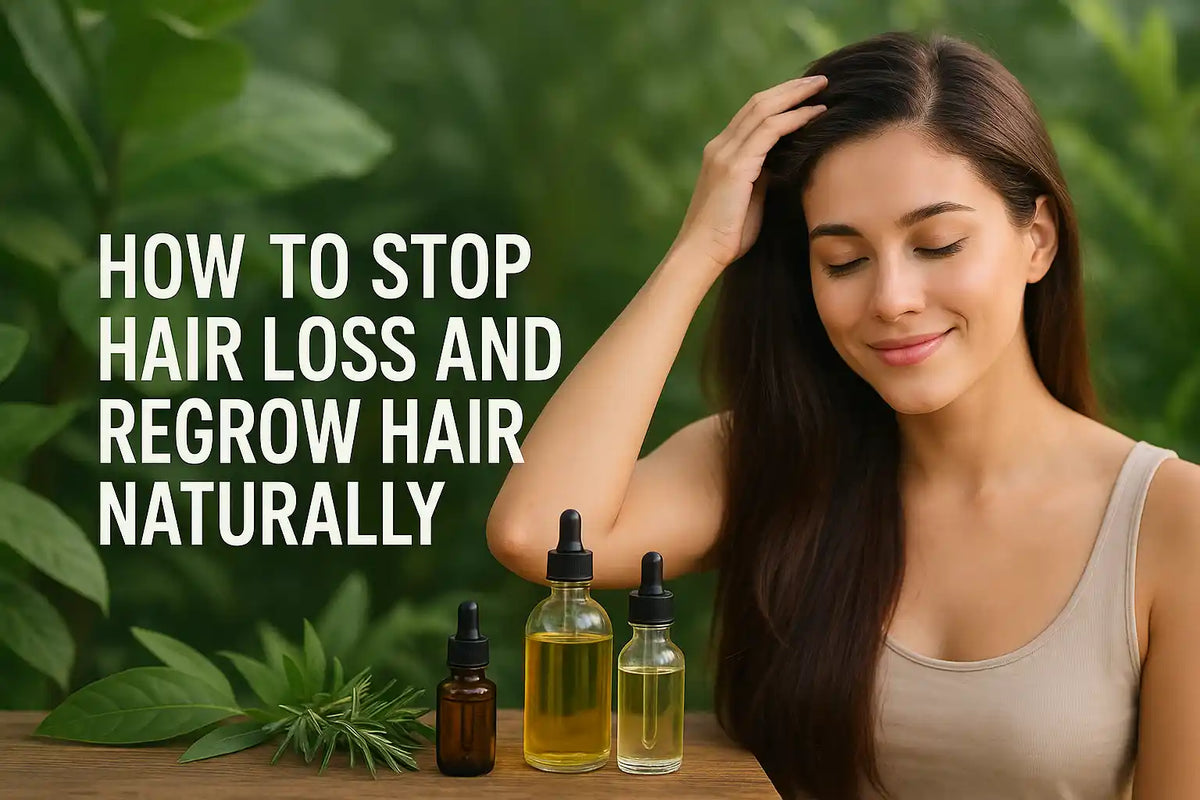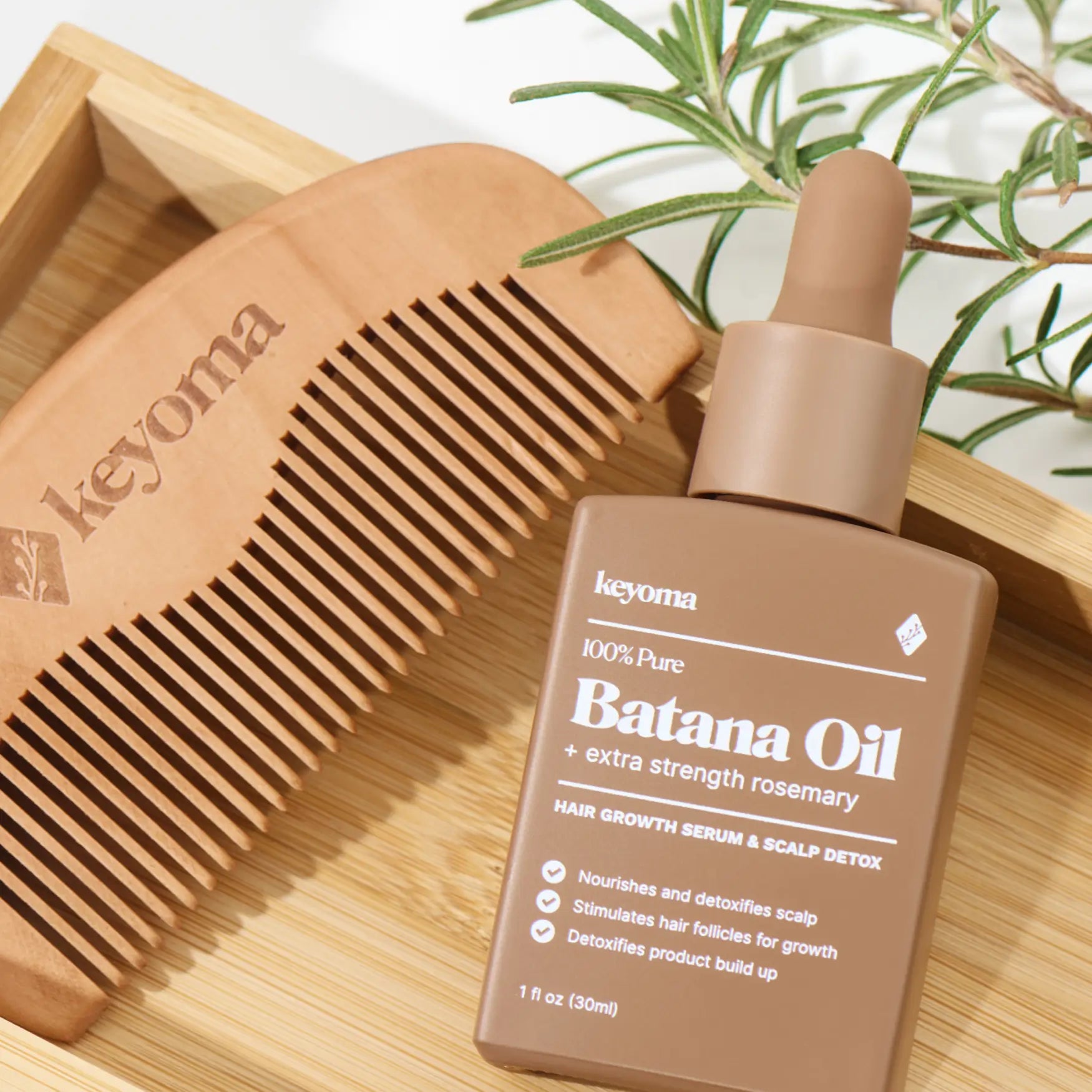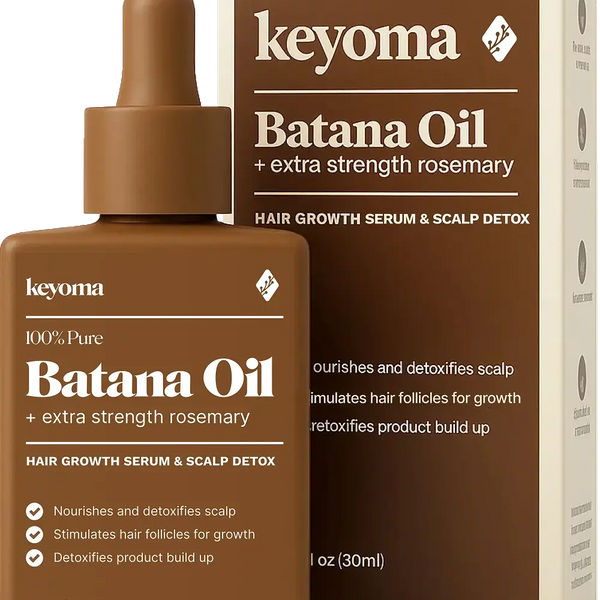In this article
You’re noticing more hair on your pillow, in your brush, or swirling around the drain.
You’re not ready to accept thinning or balding—and you don’t want prescriptions full of side effects.
We’ve studied what works and what doesn’t. This guide breaks down natural, proven ways to stop hair loss and support regrowth using safe, effective steps.
Whether you’re postpartum, stressed, or starting to thin at the crown, this is for you.
What Causes Hair Loss?
Hair loss doesn't start overnight. It builds slowly—often from a mix of triggers. Knowing the root cause helps you take targeted action.
Common reasons include:
- Hormonal shifts like postpartum changes, menopause, or thyroid imbalances
- Chronic stress, which pushes more hair into the shedding phase
- Genetics, especially for men with receding hairlines or crown thinning
- Aging, which slows down follicle renewal
- Harsh products that strip your scalp’s natural oils and damage follicles
Other overlooked triggers:
- Poor diet low in protein, iron, or vitamins
- Tight hairstyles that cause constant tension
- Overwashing or heat-styling too often
You don’t need all of these to lose hair—one or two may be enough. Identifying your triggers is the first step toward fixing them.
Can You Regrow Hair Without Chemicals or Prescriptions?
Yes, you can—but it takes patience, consistency, and the right approach.

Natural regrowth means:
- Using clean, plant-based ingredients like oils, herbs, and nutrient-rich blends
- Avoiding synthetic treatments that mask symptoms or cause side effects
- Supporting your scalp and follicles through gentle, sustained care
Who sees the most success:
- Women dealing with hormonal or postpartum shedding
- Men noticing early thinning at the crown or hairline
- Anyone reacting to harsh shampoos or chemical-laden serums
Why consistency matters:
- Hair grows slowly—about half an inch per month
- Natural remedies work with your body, not against it
- Most people see a noticeable change after 60–90 days of regular care
If you stay consistent and keep your routine clean, regrowth is possible—without prescriptions.
Natural regrowth means:
- Using clean, plant-based ingredients like oils, herbs, and nutrient-rich blends
- Avoiding synthetic treatments that mask symptoms or cause side effects
- Supporting your scalp and follicles through gentle, sustained care
Who sees the most success:
- Women dealing with hormonal or postpartum shedding
- Men noticing early thinning at the crown or hairline
- Anyone reacting to harsh shampoos or chemical-laden serums
Why consistency matters:
- Hair grows slowly—about half an inch per month
- Natural remedies work with your body, not against it
- Most people see noticeable change after 60–90 days of regular care
If you stay consistent and keep your routine clean, regrowth is possible—without prescriptions.
How to Stop Hair Loss and Regrow Hair Naturally at Home
You don’t need a clinic visit or a pharmacy to take control of your hair. You can start improving growth right where you are—at home.

These practical steps are easy to begin, low-cost, and designed to work with your body’s natural cycles. If you build them into your daily routine, your scalp and strands will respond.
Use Proven Natural Oils
The right oil can feed your scalp, wake up dormant follicles, and reduce breakage.
Start with these:
- Batana Oil – Backed by ancestral use and viral results, this oil restores moisture and supports growth. Use 2–3 times a week.
- Rosemary Oil – Shown in studies to match minoxidil’s results over time. It helps reduce inflammation and improve blood flow.
- Castor Oil – Thick, nutrient-rich, and full of ricinoleic acid to strengthen strands and promote thickness.
Apply a small amount directly to your scalp, massage in, and leave for at least 30 minutes—or overnight for deeper absorption.
Keep it simple. Choose one oil, stay consistent, and track your progress.
Massage Your Scalp Daily
Scalp massage isn’t fluff—it’s one of the easiest ways to activate your follicles and boost blood flow.
Benefits include:
- Increases nutrient delivery to roots
- Loosens buildup and dead skin
- Helps oils absorb more effectively
How to do it:
- Use your fingertips (not nails) in small circular motions for 3–5 minutes
- Apply light to medium pressure
- Use a scalp massager if your fingers get tired
- Pair with oil for deeper nourishment
Start with once per day, especially before shampooing or bedtime. The results build over time—like exercise for your scalp.
Avoid Harsh Ingredients
What touches your scalp matters. Some ingredients found in common hair products can irritate your skin and weaken follicles.
Avoid products with:
- Sulfates, which strip natural oils and dry out your scalp
- Alcohols, which cause brittleness and breakage
- Synthetic fragrances, which often trigger inflammation
Check your shampoo, conditioner, and styling products. Look for short ingredient lists and labels that say sulfate-free , fragrance-free , or plant-based .
Your scalp is skin. Treat it with the same care you’d give your face.
Nourish Hair Through Diet
What you eat shows up in your hair. Weak, slow-growing strands often point to missing nutrients.
Focus on foods rich in:
- Protein , the building block of hair (eggs, lentils, fish)
- Iron , which carries oxygen to your follicles (spinach, red meat, pumpkin seeds)
- Biotin , a B-vitamin that supports strength and thickness (nuts, sweet potatoes, oats)
- Zinc , which helps repair and grow tissue (chickpeas, seeds, dairy)
Tips to support regrowth through diet:
- Don’t skip meals—hair thrives on steady nutrition
- Stay hydrated to support scalp health
- Limit processed foods that cause inflammation
You don’t need supplements if your meals are consistent and balanced. Whole foods are more effective and easier on your body.
Protect Hair from Daily Damage
Hair doesn’t only fall from within—daily habits wear it down too.
Damage risks to watch for:
- High heat from blow-dryers, flat irons, or curling tools
- Tight styles like braids, buns, or ponytails that pull at the roots
- Rough towel drying or brushing when wet
How to prevent daily damage:
- Air-dry when possible or use a cool setting on your dryer
- Loosen your hairstyles and switch them up often
- Use a microfiber towel or cotton T-shirt to dry hair
- Comb gently from the ends upward using a wide-tooth comb
Protecting your strands helps hold onto the new growth you’re working hard to build.
Do Natural Remedies Work Overnight?
You want results fast—but real hair growth takes time.
Here's what to expect:
You might feel a difference after one night of using oils or massage (softer scalp, less itchiness)
- Visible growth or thickness usually takes 4–12 weeks
- Consistency matters more than speed
What you won’t get overnight:
- A full hairline restored in 24 hours
- Reversal of years of thinning in one week
But here's the good news:
- Daily actions can create real, visible change over time
- Some users report less shedding after the first week
- Your scalp health improves quickly, which sets the stage for growth
Give your scalp what it needs, stick with your routine, and track progress monthly—not daily
Natural Hair Growth Tips for Women and Men
Not all hair loss looks the same—and your routine should reflect that. Whether you're recovering from hormonal shifts or facing early signs of thinning, your approach should fit your situation.
These tips offer specific actions for different needs, without guesswork or trial-and-error.
Tips for Women with Hormonal Hair Loss
Hormonal shifts like pregnancy, postpartum, or menopause can throw off your hair cycle. The result is often sudden shedding or thinning at the crown.
Steps that help rebalance and support regrowth:
- Massage with natural oils like Batana or rosemary to stimulate the scalp
- Practice hair cycling —rotate between growth oils, scalp rest days, and clarifying washes
- Focus on rest and recovery —your hair responds to stress, too
- Avoid tight styles and heavy products that stress fragile roots
Stay patient. Hormonal hair loss often reverses with time, care, and consistency.
Tips for Men with Thinning at the Crown
Early thinning usually starts at the crown or hairline—and it’s easiest to manage if you catch it now.
Tactics that work best:
- Apply oil consistently —rosemary or Batana oil 3x/week to stimulate growth
- Use a soft-bristle brush to reduce pulling and friction
- Limit cap-wearing if it causes sweat buildup or tightness
- Stick to gentle shampoos —no sulfates, alcohols, or synthetic ingredients
Ask someone close to check your progress monthly. The crown is hard to see, but easy to treat with daily care.
Regrowth Checklist + When to See a Doctor
You’ve learned the causes, habits, and tools that support regrowth. Now it’s time to get practical. What should you do each week—and when should you seek expert help?
Use this checklist to stay on track, and know the signs when it’s time for professional guidance.
Daily and Weekly Habits That Help
You don’t need a long list. Just a few steady actions make the biggest difference.
Daily:
- Massage your scalp for 3–5 minutes
- Avoid tight styles and heavy product buildup
- Eat balanced meals with protein, iron, and healthy fats
- Use gentle, sulfate-free hair products
Weekly:
- Apply a natural oil like Batana or rosemary 2–3 times
- Clarify your scalp with a clean rinse or gentle exfoliant
- Air-dry your hair or use low heat only
- Track your progress with photos or notes
These small habits work together to support visible change over time.
When It’s Time to Seek Medical Help
Some hair loss needs more than routine care. If you notice sudden or severe changes, it’s time to talk to a professional.
Watch for:
- Sudden bald patches or rapid shedding
- Itchy, red, or scaly scalp
- Ongoing loss despite months of consistent care
- Family history of autoimmune conditions
How natural and clinical care can work together:
- You can continue oiling and scalp care while seeking a diagnosis
- Some dermatologists support adding natural oils to medical plans
- Bloodwork and scalp exams can identify deeper issues like hormone imbalances or deficiencies
Getting help early can make your natural routine even more effective.
See What Real Results Look Like with Keyoma
You've learned what causes hair loss, how to fight it naturally, and what routines make a real difference.
Now see the proof. Real users. Real regrowth. Backed by consistent routines and clean ingredients.
Featured Product
100% Pure Batana Oil + Rosemary









